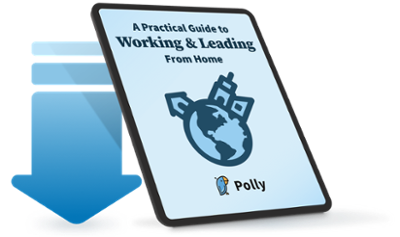The world is anxious to get back to work, but getting there will continue to be a monumental challenge, even as cities and counties begin to open back up.
While returning to “business as usual” might still seem little more than hopeful at the moment, it’s never too early to start working toward a safe, strategic, and sustainable return to at least some of the norms we’ve come to expect in the workplace.
For some organizations, that return to norms might not mean bringing people back to an office yet, and that’s OK. The safety and wellbeing of employees far outweighs any benefits of a co-located office. Those who do return to a co-located office will likely find that experience to be far from ‘normal’ anyway.
So not everyone can return to co-located work, and those who can return may not find what they’re expecting when they get there.
How do you start making progress?
During uncertain, tumultuous times, it’s difficult to know when or even where to direct your effort. With that in mind, we’re going to outline some areas where feedback from employees can be particularly valuable in guiding that effort.
It’s crucial to understand that there is no one-size-fits all plan, and your own coalition of experts will need to make the final calls on which tools, strategies, and timelines make the most sense for your situation.
No plan is perfect or 100% complete. This resource is NOT a return to work plan, and it’s not a substitute for research, due diligence, internal discussions, and professional guidance.
The information provided here is a jumping off point for gathering primary data that can help to support a safe, strategic, and sustainable return to work.
We’re all in different stages of our return-to-work journey, so if you’re focused on addressing a specific challenge, you can skip to the relevant section here:
- Information resources
- Evaluating your need to return
- Considerations for business size and type
- Employee feedback loops
Stage 1: Strengthening the Remote Experience
- Ergonomics and tools
- Communication and collaboration
- Leadership support
- Team cohesion and camaraderie
- Common barriers to returning to work
- Identifying and addressing barriers
- Assessing readiness
Stage 3: Employee Safety and Support
- Physiological needs
- Occupational safety
- Psychological safety
Stage 0: Initial Evaluations
The COVID-19 crisis continues to impact organizations and individual employees in myriad ways -- some of which still remain to be revealed.
The success of any return-to-work plan will hinge on its flexibility. As we’ve seen over the past several months, the variables that inform even the best laid plans can change dramatically in a short period of time.
Evaluate the necessity to return at all
For some organizations, there is a clear and present need to return to co-located work, but not all organizations need to return to an office. As the first few months of 2020 have proven for many teams, remote work can be sustainable on a large scale and across a protracted, even permanent timeline.
As a critical element of initial planning, getting a pulse from employees as to whether or not they prefer (or are ready) to work from home will be crucial. It may reveal that, despite the unique challenges involved, an ongoing remote work paradigm is the best way forward -- the best way to gauge that accurately is to ask.
Considerations for business size and type
Managing a return-to-work initiative might involve a great deal more moving parts for a 5,000-person organization, but that doesn’t mean it will be any more difficult than the challenges faced by a smaller organization.
There are no one-size-fits-all return-to-work plans. Even organizations of the same size often have dramatically different needs, based on their operations.
Continue listening for updates from health experts and authorities
Because the novel coronavirus impacts different communities and businesses in different ways, it’s important to stay informed through trusted sources. In these first stages, trustworthy information and updates from experts are irreplaceable.
Guidance may differ depending on which part of the world you live in, so it’s important to seek information from global, national, state, and local health authorities.
Employee Feedback loops for Stage 0:
There are a series of questions that can help evaluate the status and viability of the current state, while testing the waters for some potential future states of work.
Getting complete and candid answers to these questions from the largest possible percentage of employees is key to the value of this exercise, so they’re best asked in a format that is:
- simple
- visible
- contextual
- focused
During the initial planning phases, access to a baseline pulse of the team can help The following isn’t an exhaustive list of questions, but can be a useful benchmark to start with and track over time:
Your baseline
Throughout any major change, tracking base employee sentiment is key to understanding the aggregate impact. So while it’s valuable to dig into details, getting a pulse on everyone’s general wellbeing is crucial, especially when measured over time.
In these cases, emoji can be a useful tool for conveying sentiment and emotional context quickly. For example:
How is your week going so far?
😍 😃 😐 🙁 😢
Information access
Easy and unfettered access to factual information is essential to safe and confident operation. But it’s not just access to public health information that employees need.
Transparent organizational and team leadership will always be an element of success, but it’s more important than ever during a crisis. For that reason, it’s beneficial to confirm employees feel they’re well informed.
Questions to ask
I have sufficient access to factual information about the COVID-19 pandemic, and feel well informed about levels of risk involved with various activities.
Strongly Agree | Agree | Neutral | Disagree | Strongly Disagree
Management is communicating effectively while we work remotely.
Strongly Agree | Agree | Neutral | Disagree | Strongly Disagree
Management is communicating effectively regarding the global health crisis.
Strongly Agree | Agree | Neutral | Disagree | Strongly Disagree
The work environment
If the proliferation of remote work during the COVID-19 crisis has taught us anything, it’s that returning to work doesn’t have to mean returning to a centralized HQ -- certainly not for everyone.
Modern work environments have undergone a dramatic shift in comparison to those of the past. Many organizations rely less on centralized locations, leveraging remote work, smaller satellite offices, and a presence in co-working spaces. Employees can provide some priceless insights into which plans might work best moving forward.
Questions to ask
Given proper safety protocols and equipment, if we were to re-open our offices for co-located working, I would feel comfortable returning.
Strongly Agree | Agree | Neutral | Disagree | Strongly Disagree
Having a physical office is a significant factor in my ability to work effectively.
Strongly Agree | Agree | Neutral | Disagree | Strongly Disagree
Once back-to-work restrictions are lifted, my preference is to continue to WFH.
Strongly Agree | Agree | Neutral | Disagree | Strongly Disagree
Once back-to-work restrictions are lifted, my preference is to WFH but have the ability to use a co-working space as needed.
Strongly Agree | Agree | Neutral | Disagree | Strongly Disagree
Stage 1: Strengthening the Remote Experience
Like it or not, remote work will continue to be many employees’ norm for the foreseeable future. Twitter stated its intention to allow employees to work remotely indefinitely, while Google and Facebook advised employees that they could continue to work from home until September, or even next year.
Before taking any steps toward reopening, it’s still crucial to think about ways to improve the remote experience.
Some employees may never ‘return to work’ in the traditional sense. For those who fall into that camp, a strengthened remote work experience is vital. Those who do plan to return to co-located working will still need remote work support in the interim. Delivering that experience hinges on uncovering areas for investment and improvement, starting with broad fundamentals, then moving on to finer details.
Basic equipment
These first few questions cover simple, but paramount elements of a remote work environment. Regardless of whether or not a return to the office is imminent, supporting remote work provides a host of benefits in terms of flexibility for employees and leadership.
Questions to ask
I feel as though I have the tools I need in order to be successful in my role while I continue to work from home.
Strongly Agree | Agree | Neutral | Disagree | Strongly Disagree
I have reliable internet access at a high enough speed to do my job effectively from home.
Strongly Agree | Agree | Neutral | Disagree | Strongly Disagree
I have a comfortable workstation that doesn’t put me at risk for repetitive stress injuries.
Strongly Agree | Agree | Neutral | Disagree | Strongly Disagree
I have space that I can dedicate to work without undue hardship or distraction.
Strongly Agree | Agree | Neutral | Disagree | Strongly Disagree
Communication and Collaboration
While tools and environment are crucial elements of a WFH program, the people and protocols they support are of equal importance. Assuming everyone will “get it” on their own without guidance and support isn’t likely to produce optimal, or even acceptable results.
Ensuring a quality experience in this regard hinges on effective communication and change management protocols. How do you know they’re working? Ask.
Questions to ask
Communication with my colleagues is clear and frequent.
Strongly Agree | Agree | Neutral | Disagree | Strongly Disagree
I have the tools I need to collaborate effectively with my colleagues.
Strongly Agree | Agree | Neutral | Disagree | Strongly Disagree
Remote Team Leadership
In many meaningful ways, leading a remote team is different than leading a co-located team. Without resources and effort, it’s not reasonable to expect manager/report relationships to sustain a similar level of quality.
Candid evaluations of those relationships can help to uncover areas for improvement and greater support for both managers and their direct reports.
Questions to ask
How would you rate your relationship with your direct manager?
😍 😃 😐 🙁 😢
I feel supported by my manager while I’m working from home.
Strongly Agree | Agree | Neutral | Disagree | Strongly Disagree
My manager communicates effectively in a remote setting.
Strongly Agree | Agree | Neutral | Disagree | Strongly Disagree
On a scale of 1-10, how would you rate the effectiveness of organizational leadership?
1 - 2 - 3 - 4 - 5 - 6 - 7 - 8 - 9 - 10
Team Cohesion
In addition to communication and collaboration, camaraderie is a vital component of a high-performing team. Remote work (especially preceded by a sudden shift) can strain work relationships that took months or even years to build.
Questions to ask
Over the past few weeks, how would you rate the social connection you feel with your teammates?
😍 😃 😐 🙁 😢
For more information on improving the remote work experience, check out our recent eBook, A Practical Guide to Working and Leading from Home.
Stage 2: Readiness Assessment / Return to Work / Back to Work Pilot
When is it time to start heading back to work?
There is a great deal of national, regional, and municipal guidance on managing a safe return to work. While governmental agencies across the world can and will influence many decisions as to how and when teams get back to work, many of the details of planning, executing, and adhering to governmental guidance often falls on individual organizations.
There are coalitions of organizations working together to share knowledge and help design safe, effective return to work plans; however, each organization will have its own unique challenges to face when coming back to work.
While these resources are fundamental tools for a safe, sustainable return, it may not be possible for them to address every need or issue. Primary data gathered directly from employees can help illuminate those issues as they arise.
Addressing common barriers to returning to work
There are many visible barriers for employees getting back to work; however, there will inevitably be additional barriers that haven’t been anticipated. In order to address these hidden barriers, they must first be uncovered.
In addition to being hidden, some of these barriers may require a reliable layer of anonymity to encourage candid responses and to protect employees and their organizations.
As always, it’s vital to consult expert advice before asking sensitive questions, even if they’re being asked anonymously.
General health concerns
Even low-risk individuals may have serious concerns about the level of risk associated with going back to work in a co-located environment. Revealing those concerns early on can help guide policies that address them.
High-risk family members
Not all employees are deemed high-risk as it relates to covid-19; however, many have family members who are.
This poses a significant challenge, because while the individual may be fit to return to the office, they may fear the exposure their time in (and to/from) the office represents for their high-risk loved ones.
Lack of safety equipment
Basic risk mitigation and prophylactic safety equipment are still hard to come by in many areas. If employees don’t have a reasonable expectation of safety, they’re unlikely to return voluntarily.
Child care
Many people across the world rely on schools to educate their children, and as such, school acts as a de-facto childcare provider as well. If schools aren’t in session, it’s incumbent on parents to secure that care either through their own personal efforts, or through third-party child care providers.
In some areas, many of those providers are still either shuttered or operating under significantly reduced capacity.
This leaves many working family parents in an extraordinarily challenging situation.
Transportation
In many cities and municipalities, the public transport resources employees rely on are operating at significantly reduced capacity. If there’s limited access to public transport, public (or even private) parking, and a great enough physical distance or inclement weather such that walking or biking aren’t options, it’s not reasonable to expect employees to show up at the office.
Questions to ask:
How is your week going so far?
😍 😃 😐 🙁 😢
Given appropriate Personal Protective Equipment (PPE) and social distancing measures, I would feel safe returning to a co-located workspace.
Strongly Agree | Agree | Neutral | Disagree | Strongly Disagree
I have reliable access to safe, affordable childcare.
Strongly Agree | Agree | Neutral | Disagree | Strongly Disagree
I have access to safe, reliable transportation to and from the workplace.
Strongly Agree | Agree | Neutral | Disagree | Strongly Disagree
Stage 3: Employee Safety and Support
Employee safety is a non-negotiable requirement for a modern organization, and equally so for a successful transition back to work in a co-located office.
As employees begin to return to co-located working, providing ongoing safety measures and support will be a crucial element of success.
Occupational safety
In industries where the work that sustains them is inherently hazardous, occupational health and safety are given constant consideration and support.
In the United States, agencies like OSHA are tasked with ensuring that employees are not placed at unnecessary risk during the course of their work; however, its ability to address these issues during a pandemic will almost certainly be strained.
Until the novel coronavirus is reliably contained or eradicated, every workplace will need to address health and safety with a renewed focus and sense of accountability.
Self-certification
It may not be feasible or even possible to objectively confirm the health status of every employee in an organization, so in at least some capacity, self-certification may need to be part of the equation.
In a self-certification program, employees regularly state their health and fitness for work in a co-located office.
Personal protective equipment (PPE)
Providing PPE including but not limited to face masks and hand sanitizer should be table stakes for any reopening plan. For employees to feel safe enough to focus on their work, they need free access to life-preserving equipment.
Social distancing measures
Maintaining minimum distances will be crucial as employees return to work in a co-located setting. If an office can’t be outfitted and organized in such a way that employees are able to work from a sufficiently safe distance from one another, it’s not time to reopen.
Policy adherence
There are multiple elements of occupational safety, and the human element is one of the more challenging to address.
Policies and procedures are only as good as their execution. If nobody follows the safety policies that are in place, a return-to-work program can quickly become a return-to-work-from-home program.
Audit Logs
In order to coordinate in response to feedback and track the source of both failures and successes, having an auditable system of record will be crucial.
Questions to ask
I have safe, adequate access to food, water, and restrooms while maintaining social distancing procedures.
Strongly Agree | Agree | Neutral | Disagree | Strongly Disagree
I have unfettered access to Personal Protective Equipment (PPE) and other safety materials.
Strongly Agree | Agree | Neutral | Disagree | Strongly Disagree
My colleagues and I are using Personal Protective Equipment (PPE) consistently and effectively.
Strongly Agree | Agree | Neutral | Disagree | Strongly Disagree
My colleagues and I are able to practice social distancing effectively.
Strongly Agree | Agree | Neutral | Disagree | Strongly Disagree
As an office, we are doing an effective job practicing social distancing.
Strongly Agree | Agree | Neutral | Disagree | Strongly Disagree
Do you have any other feedback you’d like to share?
Free text
Psychological safety and support
This focus on safety doesn’t need to end with physical safety. Psychological safety and general wellbeing are also crucial elements of a safe, healthy work environment.
The questions that are (or aren't) asked reveal a lot about an organization's priorities. Even in the best of times, it's important for employees to know their organization prioritizes their health and well-being. In times of crisis, this is even more essential.
Questions to ask
How is your week going so far?
😍 😃 😐 🙁 😢
I feel safe coming in to work.
Strongly Agree | Agree | Neutral | Disagree | Strongly Disagree
I feel secure in reporting issues as they become visible, and have a reliable method of doing so.
Strongly Agree | Agree | Neutral | Disagree | Strongly Disagree
Moving Forward
As with any initiative that impacts them, employees will continue to be one of the most valuable and reliable sources of empirical data on a return-to-work plan’s effectiveness.
Continued collaboration will help to reveal what’s working, what isn’t, and how to provide a safer, more seamless transition back to co-located work.











